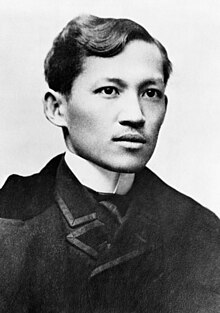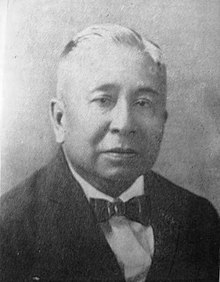Anarchism in the Philippines
| Part of a series on |
| Anarchism |
|---|
 |
Anarchism in the Philippines has its roots in the anti-colonial struggle against the
History
The roots of anarchism in the Philippines lie in the numerous Philippine revolts against Spain during the Spanish Colonial Period. One of the earliest signs of resistance was the Battle of Mactan, in which native warriors led by Lapulapu overpowered and defeated the forces of the Spanish Empire, resulting in the death of Ferdinand Magellan.[1] A commonly cited revolt is the uprising led by Tamblot in 1621, during which 2000 indigenous rebels burnt down the Christian churches and monuments throughout the island of Bohol.[2] This uprising spilled over to the island of Leyte, where the Bankaw revolt took place.[3] The Spanish military brutally suppressed the uprisings and executed many of the rebels, under orders by the clergy.[4] The Moro people also led a prolonged conflict against the Spanish in Mindanao, which prevented the empire from subjugating much of the southern archipelago for most of its history there.
The many diverse indigenous communities that inhabited the various islands of the archipelago were not submitted to any centralized
Anarchism in the national liberation movement

Filipino nationalism began to spread rapidly throughout the archipelago following the Glorious Revolution of 1868. A number of Filipino intellectuals, including José Rizal and Marcelo H. del Pilar, launched a Propaganda Movement which called for reforms to the governance of the Spanish East Indies.[6][7] In 1890, Rizal had moved to Europe, where he became acquainted with the French and Spanish anarchist movements. In Spain, Rizal was mentored by the Proudhonist federalist Fransisco Pi y Margall.[8][9] The idea of propaganda of the deed particularly inspired Rizal's second novel El filibusterismo, which depicts a revolution of national liberation against the Spanish colonial authorities in the Philippines.[10] In that book, Rizal depicted a failed attempt at propaganda of the deed through his character "Simoun" who tried to bomb a party attended by colonial elites.[10] Upon his return to Manila in 1892, Rizal founded the La Liga Filipina, a secret society dedicated to mutual aid and the establishment of cooperatives, among other activities.[9] Rizal was arrested for his activities in the league and deported to Dapitan.[11] There he built a hospital, a water supply system and a school, where he taught and engaged in farming and horticulture.[12]
Upon the deportation of Rizal, many Filipino nationalists established the

During the revolution,
The rise of Communism
As part of the
When the Japanese occupation of the Philippines began, a resistance movement was organized in the archipelago to wage a guerilla war against the occupation forces. Peasants led by Juan Feleo organized the Hukbalahap, which played a key role in wresting control of Luzon from the Japanese Empire.[21] In 1945, the Japanese-sponsored Second Philippine Republic was brought down and the Commonwealth re-established.
Shortly following the independence of the Third Philippine Republic, Feleo was assassinated by the administration of Manuel Roxas, beginning the Hukbalahap Rebellion against the republic.[36] After negotiations between the two sides failed, the Hukbalahap forces began to dwindle.[37] The rebellion was finally put down in 1954 and the guerilla leader Luis Taruc was forced to surrender.[38] The Communist Party was once again outlawed and continued repression caused their movement to falter during the 1960s. This led to the First Great Rectification Movement, in which the Nationalist Youth (KM) led by Jose Maria Sison began to criticize the old Communist Party for its failures and initiated a process intended to revitalize the communist movement.
With the
In 1970, the SDK aligned itself once again with the KM, which initiated a purge of the SDK leadership and restructured the group along more tightly organized lines, renaming it to the "Democratic Federation of Youth".[45] The anarchist tendencies within the SDK were subsequently pushed to the fringes of the organization, causing an explicitly anarchist group led by Jerry Araos to form, known as the Federation of Democratic Youth - Mendiola (SDKM).[46] The SDKM adopted the black flag as its symbol and began to form the front-lines at protests, earning the nickname "gunpowder brains" due to their inclination towards violence, use of explosives and construction of pillboxes.[47]
The SDKM played a prominent role during the First Quarter Storm; during the battle on Mendiola Street a fire truck being used to blast protestors with water was commandeered by the SDKM, who used it as a battering ram against the gates of Malacañang Palace. When a number of explosions forced the retreat of protestors away from the palace, they constructed barricades along the bridge. When the SDK leader Sixto Carlos called on the SDKM for help, members of the SDKM posted themselves at every barricade.[47] Protestors battled with the police on the bridge for several hours, but the barricades eventually fell and the protestors were again forced to retreat.[48] In February 1971, a student uprising at the University of the Philippines Diliman led to the establishment of the Diliman Commune. Here too, members of the SDKM played a prominent role at the barricades, but according to Araos, the barricades only fell due to an order from the Communist Party to abandon them.[47] The SDKM was eventually brought back into alignment with the SDK, now engaged in community service work and the organization of small protests. The two eventually merged entirely, with Jerry Araos being elected vice-chair of the newly united SDK.[49] However, due to these waves of protests, on September 23, 1972, Marcos proclaimed martial law in the Philippines, marking the beginning of an era of military dictatorship. Many of the existing communist organizations, including the SDK, were driven underground in the repression and were eventually dissolved by 1975.[50]
Despite playing a prominent role in the resistance to the Marcos dictatorship,
Resurgence of the anarchist movement
In the 1970s, the Filipino anarchist movement began to reemerge as part of the nascent punk subculture in the archipelago, bringing with it a strong philosophy of anti-authoritarianism. Under the dictatorship, punk music was brought to the country by returning members of the diaspora, and was broadcast illegally throughout Manila, giving rise to the Pinoy punk movement. Punk music gave an expression to youth dissatisfaction with conservative society and began to develop an explicitly political nature during the 1980s, with many punks explicitly espousing anarchist ideas.[54]
The fragmentation of the Communist Party in the wake of the People Power Revolution led to a further surge of anarchist activity in the archipelago.
The anarchist movement continued to attract people throughout the 1990s, particularly after the
In the wake of these revolutions, contemporary Filipino anarchists such as Bas Umali began to call for the dismantling of the Philippine nation-state and the establishment of a decentralized "archipelagic confederation" in its place.
See also
References
- OCLC 4822572656.
- ^ Blair, Emma (1906). The Philippine Islands, 1493-1898 Vol. 38. Arthur H. Clark Company. pp. 87–94.
- OCLC 958017661.
- ^ Piedad-Pugay, Chris Antonette. "The Revolts before the Revolution". Manila: National Historical Institute. Archived from the original on 10 March 2007. Retrieved 21 November 2006.
- OCLC 900446786.
- ISBN 971-550-209-1.
- ISBN 971-8711-06-6.
- OCLC 864023954.
- ^ OCLC 950730261.
- ^ OCLC 875370534.
- ^ Zaide, Gregorio F. (1976). Rizal: His Exile to Dapitan. St. Mary's. p. 193. Retrieved 19 August 2019.
- ^ Gibbs, Eloise A. (1960). Rizal in Dapitan: A Story Based on the Life of José Rizal During His Exile in Dapitan. University Book Supply. p. 230. Retrieved 20 August 2019.
- ISBN 971-8711-06-6
- ISBN 978-971-27-0418-5.
- ^ Guererro, Milagros; Encarnacion, Emmanuel; Villegas, Ramon (1996), "Andres Bonifacio and the 1896 Revolution", Sulyap Kultura, 1 (2), National Commission for Culture and the Arts: 3–12, archived from the original on 2010-11-15, retrieved 2009-07-08
- ^ Russell, Charles Edward; Rodriguez, Eulogio Balan (1923). The hero of the Filipinos: the story of José Rizal, poet, patriot and martyr. The Century co. p. 308.
- ISBN 971-8711-06-6.
- ISBN 978-1-103-32481-1.
- OCLC 76895524.
- OCLC 1187047203.
- ^ OCLC 969406494.
- OCLC 76895524.
- OCLC 76895524.
- OCLC 756771087.
- OCLC 4636899601.
- OCLC 246725565.
- OCLC 76895524.
- ISBN 9789712317552.
- OCLC 756771087.
- ^ Santos, Lope K. (1988). Banaag at Sikat. Philippines: Bookmark.
- OCLC 1112676175.
- ^ a b Fegan, Brian (1982). "The Social History of a Central Luzon Barrio". In McCoy, Alfred; de Jesus, Ed (eds.). Philippine Social History: Global Trade and Local Transformation. Sydney: Allen & Unwin. p. 107.
- OCLC 1200091334.
- ^ Evangelista, Crisanto (August 1929). The Split in the Philippine Labour Congress: Agents of U.S. Imperialists and Native Bourgeoisie Fail to Capture Congress. Vol. 1. The Red International of Labor Unions. p. 300.
- ^ The People of the Philippine Islands v. Crisanto Evangelista, et al., GR L-36278 SCRA (Phil. 1932).
- ^ Lachica, Eduardo (1971). The Huks: Philippine Agrarian Society in Revolt. New York: Preager Publishing.
- ISBN 978-0-8371-6669-8.
- ISBN 978-0-521-62948-5.
- ^ "A Short History of the Partido Komunista ng Pilipinas". Partido Komunista ng Pilipinas-1930. Archived from the original on November 7, 2017. Retrieved November 5, 2017.
- OCLC 943946203.
- OCLC 1020063177.
- ^ a b Gomez, Jim (20 August 2016). "AP Explains: Who are the Philippines' Communist Rebels?". Associated Press. Manila. Retrieved 25 July 2021.
- ^ Liwanag, Armando (December 26, 1988). "Brief Review Of The History Of The Communist Party Of The Philippines". Philippine Revolution Web Central. Retrieved January 8, 2016.
- OCLC 1222598208. Archived from the original(PDF) on 4 March 2016. Retrieved 10 January 2016.
- OCLC 1020063177.
- OCLC 943946203.
- ^ OCLC 943946203.
- OCLC 875270082.
- OCLC 943946203.
- OCLC 1020063177.
- ^ Abinales, Patricio (25 November 2016). "Marcos and Mindanao: The non-Moro zones". Rappler. Pasig. Retrieved 25 July 2021.
- GMA News. Retrieved 5 November 2017.
- ^ a b c Cuevas-Hewitt, Marco (2016). "10. The anarchists" (PDF). Re-imagined communities: The radical imagination from Philippine independence to the postcolonial present (Thesis). University of Western Australia. p. 293.
- ^ OCLC 919085683.
- OCLC 939095270.
- OCLC 474607527. Retrieved 8 February 2012.
- OCLC 939095270.
- ^ Cuevas-Hewitt, Marco (2016). "10. The anarchists" (PDF). Re-imagined communities: The radical imagination from Philippine independence to the postcolonial present (Thesis). University of Western Australia. pp. 298–300.
- ^ ISBN 978-1-4051-9807-3.
- ^ Cuevas-Hewitt, Marco (2016). "10. The anarchists" (PDF). Re-imagined communities: The radical imagination from Philippine independence to the postcolonial present (Thesis). University of Western Australia. pp. 300–303.
- ^ Cuevas-Hewitt, Marco (2016). "10. The anarchists" (PDF). Re-imagined communities: The radical imagination from Philippine independence to the postcolonial present (Thesis). University of Western Australia. pp. 304–306.
- ^ Cuevas-Hewitt, Marco (2016). "10. The anarchists" (PDF). Re-imagined communities: The radical imagination from Philippine independence to the postcolonial present (Thesis). University of Western Australia. p. 308.
- ^ Cuevas-Hewitt, Marco (2016). "10. The anarchists" (PDF). Re-imagined communities: The radical imagination from Philippine independence to the postcolonial present (Thesis). University of Western Australia. p. 311.
- ^ Umali, Bas (26 April 2006). "Archipelagic Confederation". Anarkismo.net. Retrieved 25 July 2021.
- ^ Del Mundo, Rubi (2021-04-21). "Mutual Aid, Community Pantries Bring Out the Best in Filipinos and the Worst in Duterte's Inhumane Regime". Philippine Revolution Web Central.
- ^ Mendizábal, L. S. (2021-04-27). "Putting Back the "Community" in Community Pantry". Kodao.
- OCLC 243915470. Retrieved 25 July 2021.
- OCLC 42725386. Retrieved 25 July 2021.
- OCLC 819413184. Retrieved 25 July 2021.
Further reading
- Hermes, Karen Louise (June 2023). "Anarchist forms of organising and bayanihan (solidarity) in the face of a Philippine state of calamities". Anarchist Developments in Cultural Studies. 2023 (1): 35–58. ISSN 1923-5615.
- MacDonald, Charles J-H (June 2023). "The Filipino as Libertarian Contemporary Implications of Anarchism". Anarchist Developments in Cultural Studies. 2023 (1): 97–125. ISSN 1923-5615.
External links
- Bandilang Itim - Filipino anarchist publication
- Philippines section - The Anarchist Library
- Philippine section - The Southeast Asian Anarchist Library
- Tagalog section - The Southeast Asian Anarchist Library
- Philippines section - Libcom.org
